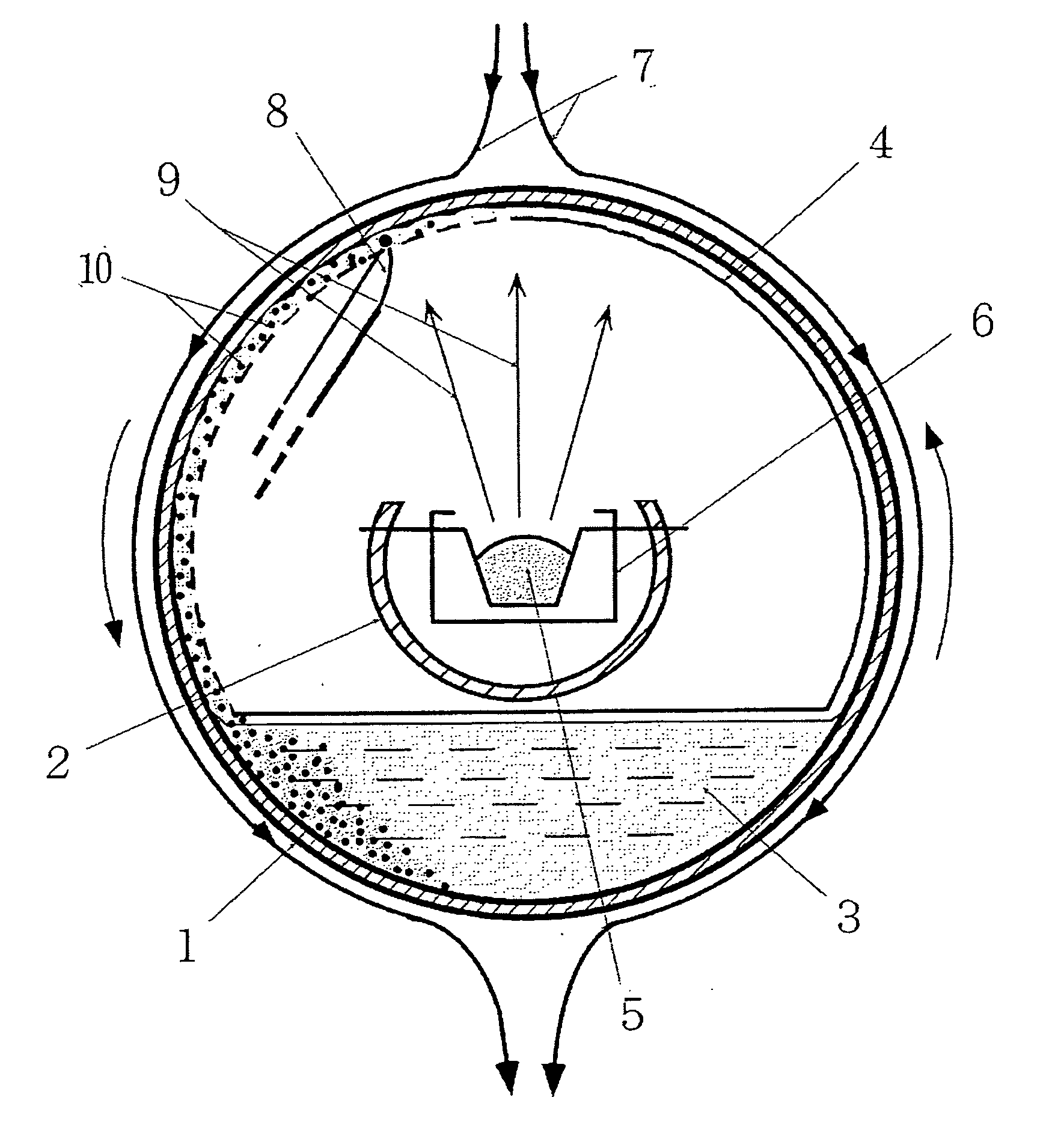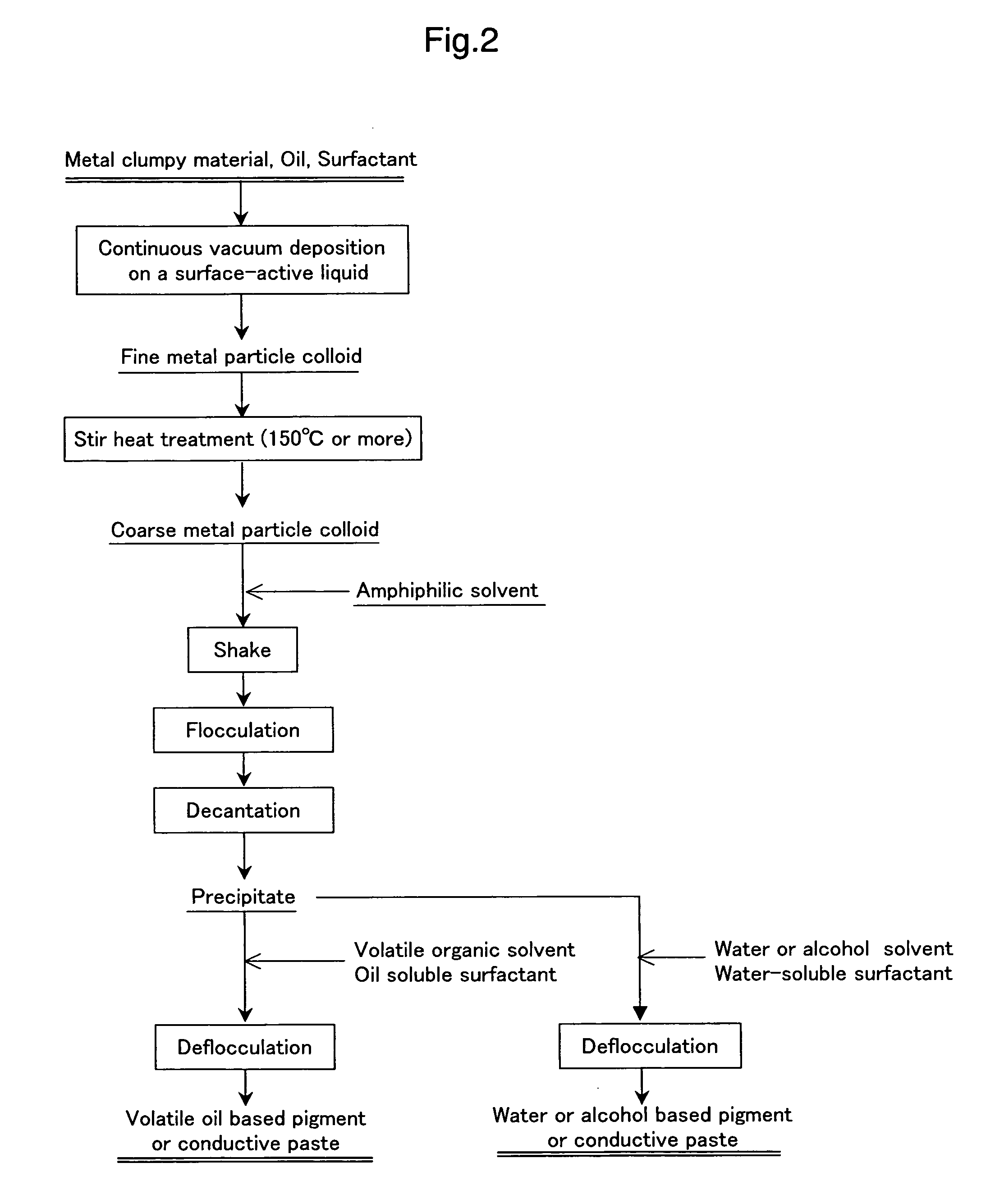Fine Metal Particle Colloidal Solution, Conductive Paste Material, Conductive Ink Material, and Process for Producing the Same
a technology of colloidal solution and fine metal particles, which is applied in the field of colloidal solution, can solve the problems of large porosity after baking, remarkable drawback of conductive ink or conductive paste manufactured by the method described above, and cannot be used in the direction of other chemical processes, applications, conductors, etc., and achieves the effect of strong fractionation
- Summary
- Abstract
- Description
- Claims
- Application Information
AI Technical Summary
Benefits of technology
Problems solved by technology
Method used
Image
Examples
example
Example 1
Preparation of Octane-Based Gold Colloidal Pigment
[0071]An alkylnaphthalene based gold colloid was prepared by the method of continuous vacuum deposition on a surface-active liquid shown in FIG. 1 using 150 cc of 5% alkylnaphthalene solution of succinic acid polyamine imide as a base solution and about 30 g of bulky gold as an evaporation material. The succinic acid polyamine imide is a dispersant and the alkylnaphthalene is a dispersion medium. About 70% of the gold metal charged in the evaporation source is effectively taken into the solution and the concentration of the gold dispersion phase is about 12%. The obtained gold colloidal particle has a uniform size of about 5 nm and the density of the number of particles is 1.4×1017 / cc. In this stage, the gold colloid does not exhibit clear coloration but is black like India ink. Then, the entire amount of the gold colloid is transferred to the stirring heat treatment apparatus shown in FIG. 3 and heated at 200° C. for 30 min...
example 2
Preparation of Octane-Based Silver Colloidal Pigment
[0072]An octane-based silver colloidal pigment can also be prepared by the same process as for the gold colloidal pigment in Example 1. The silver colloid obtained by the active liquid surface continuous vacuum vapor deposition method has an average grain size of about 7 nm and, when prepared at an identical ratio of starting materials as with that in Example 1, while the concentration of the silver dispersion phase is also about 12%, the density of the number of particles is 5.7×1016 N / cc. The appropriate condition for the stirring heat treatment is at 160 to 220° C. for 30 min. Along with increase in the stirring heat treatment temperature, the grain size of the silver colloid increases to 15 to 50 nm and, at the same time, obtained color tone changes variously. At the heat treatment temperature of 160° C., 200° C., and 220° C., silver colloidal pigments of pink, red-purple and blue purple colors are obtained respectively. The co...
example 3
Water-Based Silver Colloidal Conductive Paste and Conductive Ink
[0073]The process for obtaining cake-like fine silver particle precipitates is identical with the production process for the octane-based silver colloidal pigment of Example 2. An aqueous 10% solution of dodecyl benzene sulfonate is added to the cake-like fine silver particle precipitates in an amount three times as much as the fine silver particle precipitates and they are shaken under stirring by which precipitates are flocculated to obtain highly fluidizing water-based silver colloidal paste. Further, when the aqueous solution described above is added by 5 to 10 times amount, the viscosity is further lowered and a water-based silver colloidal conductive ink suitable to ink jet printing or the like can be produced. The color tone is black having metallic luster. It is also possible to produce an alcohol-based rapidly drying silver colloidal conductive ink by using ethyl alcohol (C2H5OH) or isopropyl alcohol (C3H7OH) i...
PUM
| Property | Measurement | Unit |
|---|---|---|
| Grain size | aaaaa | aaaaa |
| Temperature | aaaaa | aaaaa |
| Color | aaaaa | aaaaa |
Abstract
Description
Claims
Application Information
 Login to View More
Login to View More - R&D
- Intellectual Property
- Life Sciences
- Materials
- Tech Scout
- Unparalleled Data Quality
- Higher Quality Content
- 60% Fewer Hallucinations
Browse by: Latest US Patents, China's latest patents, Technical Efficacy Thesaurus, Application Domain, Technology Topic, Popular Technical Reports.
© 2025 PatSnap. All rights reserved.Legal|Privacy policy|Modern Slavery Act Transparency Statement|Sitemap|About US| Contact US: help@patsnap.com



